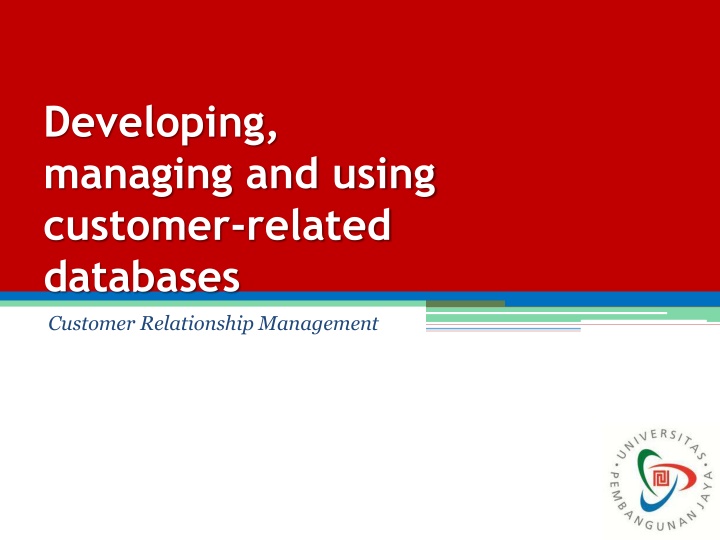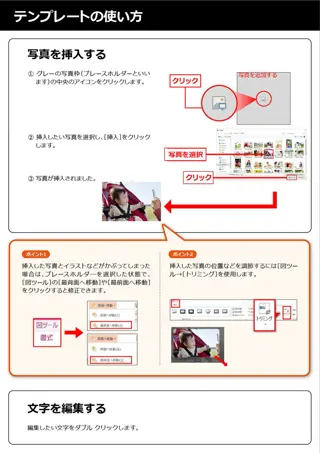
Maximizing CRM Success through Effective Database Management
Explore the significance of customer-related databases in Customer Relationship Management (CRM) outcomes. Learn the importance of quality data, data integration, data warehouse, data mart, data access, and data protection. Understand the process of developing, managing, and utilizing customer-related databases for successful CRM implementation.
Download Presentation

Please find below an Image/Link to download the presentation.
The content on the website is provided AS IS for your information and personal use only. It may not be sold, licensed, or shared on other websites without obtaining consent from the author. If you encounter any issues during the download, it is possible that the publisher has removed the file from their server.
You are allowed to download the files provided on this website for personal or commercial use, subject to the condition that they are used lawfully. All files are the property of their respective owners.
The content on the website is provided AS IS for your information and personal use only. It may not be sold, licensed, or shared on other websites without obtaining consent from the author.
E N D
Presentation Transcript
Developing, managing and using customer-related databases Customer Relationship Management
Customer Relationship Management Learning Objectives By the end of this chapter, you will understand: 1. the central role of customer-related databases to the successful delivery of CRM outcomes 2. the importance of high quality data to CRM performance 3. the issues that need to be considered in developing a customer-related database 4. what data integration contributes to CRM performance 5. the purpose of a data warehouse and data mart 6. how data access can be obtained by CRM users 7. the data protection and privacy issues that concern public policy makers.
Customer Relationship Management What is a customer-related database? Why? Companies typically do not have a single customer database; instead, they have a number of customer- related database. Large organizations, such as financial service companies, can have 20 or more customer systems, each with a separate database. customer-related database might be maintained in a number of functional areas sales, marketing, service, logistics and account- each serving different operational purposes. Customer-related database can have a current, past or future perspective, focusing upon current opportunities, historic sale or potential opportunities.
Customer Relationship Management Developing a customer-related database Most databases share a common structure of files, records and fields (also called table, rows and columns). Files (table) Hold information on a single topic such as customers, products, transactions or service requests. Each file (table) contains a number of records (rows). Each record (row) contains a number of elements of data. These elements are arranged in common sets of fields (columns) across the table. The modern customer- related database therefore resembles a spreadsheet. There are six major step in building a customer- related database, as shown in Figure 4.1
Customer Relationship Management 1. Define the database functions Database support the four form of CRM: 1. Strategic CRM needs data about markets, market offerings, customers, channels, competitors, performance and potential to be able to identify which customers to target for customer acquisition, retention and development, and what to offer them. 2. Collaborative CRM implementations generally use the operational and analytical as described below, so that partner in distribution channels can align their efforts to serve end-customers.
Customer Relationship Management 1. Define the database functions 3. Operational CRM users customer-related data to help in the everyday running of the business. For example: a telecoms customer service representative needs to access a customer record when she receives a telephone query a hotel receptionist needs access to a guest s history so that she can reserve the preferred type of room smoking or non-smoking, standard or de-luxe a salesperson needs to check a customer s payment history to find out whether the account has reached the maximum credit limit.
Customer Relationship Management 1. Define the database functions 4. Analytical CRM uses customer-related data to support the marketing, sale and service decision that aim to enhance the value created for and from customer. For example: the telecoms company might want to target a retention offer to customer who are signaling an intention to switch to a different supplier the hotel company might want to promote a weekend break to customers who have indicated their complete delight in previous customer satisfaction surveys a sale manager might want to compute his sales representatives customer profitability, given the level of service that is begin provided.
Customer Relationship Management 2. Define the information requirements The people best placed to answer the question what information is needed? are those who interact or communicate with customer for sales, marketing and service purposes, and those who have to make strategic CRM decisions. A direct marketer who is panning an e-mail campaign might want to know open and click-through rates, broken down by target market. She would also want to know e-mail address, e-mail preferences (html or plain text), and preferred solution (first name? Mr.? Ms.?). Operational and analytical needs like these help define the contents of customer-related database.
Customer Relationship Management Customer information fields Most CRM software has predefined fields in different modules, Whether for sales, marketing or service application. For example, in a sales application, a number of field (columns) of information about customers are common: Contact data: name ,invoice addresses, phone number, fax number, e-mail addresses, street addresses etc. Contact history: Who, When, about what, with what outcome Transactional history: What has the customer bought and when? What has been offered to the customer, but not been purchased?
Customer Relationship Management Customer information fields Current pipeline: What opportunities are currently in the sales pipeline? What is the value of each opportunity? What is the probability of closing? Some CRM applications enable sales people to allocate red, amber or green signals to opportunities according to the probability of success. Opportunities: Whereas transactional history looks backwards, opportunity looks forwards. This is opportunities that have not yet been opened or discussed are recorded. Products: What product does the customer have? When were these products purchased, and when are they due for renewal? Have there been any service issues related to these products in the past? Communication preferences: What is the preferred medium of communication mail, telephone, e-mail, face-to-face, etc.? Amazon.com, for example, allows customer to opt to receive e-mail about six different types of content:
Customer Relationship Management 3. Identify the information sources Information for customer-related database can be sourced internally or externally. Prior to building the databaseit is necessary audit to the company to find out what data variable. Internal data are the foundation of most CRM programmes, though the amount of information available about customer depends on the degree of contact that the company has with the customer. Some company sell through partners, agents and distributors and have little knowledge about the demand chain beyond their immediate contact.
Customer Relationship Management 4. Select the database technology and hardware platform Customer-related data can be stored in a database in a number of different ways. hierarchical network Relational
Customer Relationship Management 4. Select the database technology and hardware platform Hierarchical and network database were the most common form between the 1960s and 1980s. The hierarchical database is the oldest form and not well suited to most CRM applications. You can imagine the hierarchical model as an organization chart or family tree, in which a child can have only one parent can have one parent, but a parent can have many children.
Customer Relationship Management 4. Select the database technology and hardware platform Relational database are now the standard architecture for CRM Applications (see Figure 4.3)
Customer Relationship Management 4. Select the database technology and hardware platform The choice of hardware platform is influenced by several conditions: The size of the database. Even standard desktop PCs are capable of storing huge amounts of customer data. However, they are not designed for this data to be shared easily between several users. Existing technology. Most companies will already have technology that lends itself to database applications. The number and location of users. Many CRM applications are Quite simple, but in an increasingly global marketplace the hardware may need very careful specification and periodic review. For example , the hardware might need to enable a geographically dispersed, multilingual, user group to access data foe both analytical and operational purposes
Customer Relationship Management 5. Populate the database Having decided what information is needed and the database and hardware requirements, the next task is to obtain the data and enter it onto the database. CRM applications need data that are appropriately accurate. One of the biggest issues with customer data is not so much incorrect data as missing data. Many organizations find it difficult to obtain even basic customer data, such as e-mail addresses and preferences. The main steps in ensuring that the database is populated with appropriately accurate data are as follows: ource the data verify the data validate the data de-duplicate the data merge and purge data from two or more source
Customer Relationship Management 6. Maintain the database User with administrative rights can update records. Database updating and maintenance is also enabled by database query language. Common languages are SQL (Structured Query Language) and QBE (Query By Example). Maintenance queries available in SQL include UPDATE, INSERT and DELETE commands.
Referensi Customer Relationship Management - Concepts and Technologies, Second edition, Francis Buttle

















